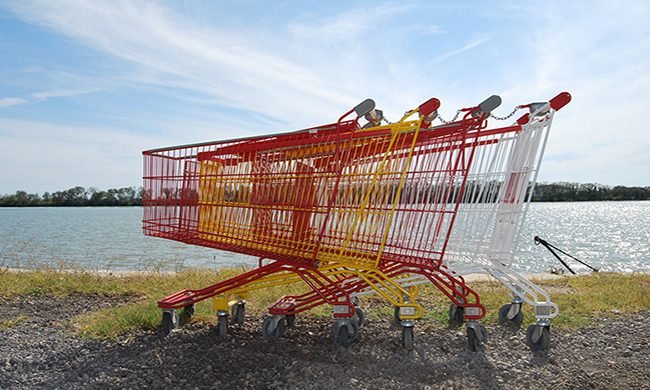New York's Surprisingly Fragile Food Chain
Author: Lowell Clare
Publication date: 21 February 2021
The abundance of options available for the consumption and purchase of foods in New York City belies the relative instability of local supply chains. These systems will be increasingly stressed as the climate crisis becomes more severe. According to the Hunter College New York City Food Policy Center over 5.7 million tons of domestic and international food is sent to New York City every day, 95% comes via truck and 60% of produce stops over in Hunts Point from where it is distributed.[1] These metrics tell us that most of the fresh foods consumed in New York City comes from other places. As the climate crisis puts increased pressure on global food production, it will also stress the supply chains that make it available to New York City’s 8,336,817 residents. [2] Aside from the climate crisis threatening food production by destabilizing growing regions, sea level rise will distress the infrastructure used to bring that food into New York City.
Canned and other forms of shelf stable foods will become more precious over time. The USDA defines shelf stable foods as those that can be stored at room temperature. In order to become stable, perishable items must be dried or heated to kill of food illness causing bacteria. [3] In order to prolong the life of these foods the FDA recommends storing them on high shelves to prevent contact with potentially contaminated flood waters and where appropriate, grouping together in a freezer. [4] In an ideal situation, meaning a temperature controlled and dry environment, commercially canned foods will retain their optimal flavor and nutritional content for 2-5 years after manufacture; that should correspond to the ‘best by’ date imprinted on the can. [5] Cans that are left out (such as those forgotten in the car on a winter's evening) can freeze, thaw and swell up. As swelling can also be a sign of contamination from botulism (Clostridium botulinum) the USDA recommends not attempting to consume any swollen cans at all. [6] Botulism is a relatively rare, but lethal bacteria. Low acid vegetables like beets, beans and peas that could have picked up Clostridium botulinum spores in the soil where they were grown are particularly at risk. [7] Generally speaking high acid canned foods like pineapple, sauerkraut, berries or anything treated with vinegar have a best by date between 12-18 months from the time of manufacture while low acid foods like corn, carrots and peas will retain flavor and nutritional value for as long as 5 years. [8] According to the Can Manufacturers Institute the ‘best by’ and ‘use by’ dates indicate the period of optimal flavor and texture, since canning is a high heat process the foods should be safe to eat (even if less palatable) after those dates if they have been properly stored.[9] Canned food with especially high acid content, like tomatoes, can interact with the metal of the can causing corrosion from the inside out, this speeds up changes in flavor and lowered nutritional content. [10] Testing has proven that foods preserved in Mylar®-type pouches can keep as long as 10 years if properly stored. [11] According to the USDA most canned foods are safe to eat for many years as long as they have been properly stored and the cans are free of rust, denting and swelling. [12]
[1] NYC Food by the Numbers. September 16, 2014. https://www.nycfoodpolicy.org/nyc-food-numbers-climate-change-food-supply/
[2] United States Census New York City Quick Facts. July 2019. <https://www.census.gov/quickfacts/newyorkcitynewyork>
[3] “Shelf-Stable Food Safety.” United States Department of Agriculture. March 24, 2015. https://www.fsis.usda.gov/wps/portal/fsis/topics/food-safety-education/get-answers/food-safety-fact-sheets/safe-food-handling/shelf-stable-food-safety/ct_index
[4] Food and Water Safety During Power Outages and Floods. https://www.fda.gov/food/buy-store-serve-safe-food/food-and-water-safety-during-power-outages-and-floods
[5] ibid.
[6] “Shelf-Stable Food Safety.” United States Department of Agriculture. March 24, 2015. https://www.fsis.usda.gov/wps/portal/fsis/topics/food-safety-education/get-answers/food-safety-fact-sheets/safe-food-handling/shelf-stable-food-safety/ct_index
[7] “Shelf-Stable Food Safety.” United States Department of Agriculture. March 24, 2015. https://www.fsis.usda.gov/wps/portal/fsis/topics/food-safety-education/get-answers/food-safety-fact-sheets/safe-food-handling/shelf-stable-food-safety/ct_index
[8] “Shelf-Stable Food Safety.” United States Department of Agriculture. March 24, 2015. https://www.fsis.usda.gov/wps/portal/fsis/topics/food-safety-education/get-answers/food-safety-fact-sheets/safe-food-handling/shelf-stable-food-safety/ct_index
[9] Canned Foods: Frequently Asked Questions. Can Manufacturers Institute. https://www.cancentral.com/sites/cancentral.com/files/public-documents/CMI_FAQ_2016_FINAL.pdf
[10] “Shelf-Stable Food Safety.” United States Department of Agriculture. March 24, 2015. https://www.fsis.usda.gov/wps/portal/fsis/topics/food-safety-education/get-answers/food-safety-fact-sheets/safe-food-handling/shelf-stable-food-safety/ct_index
[11] Food and Water Safety During Power Outages and Floods. https://www.fda.gov/food/buy-store-serve-safe-food/food-and-water-safety-during-power-outages-and-floods
[12] “Before You Toss Food, Wait! Check it Out.”Marianne Gravely. February 21, 2017. https://www.usda.gov/media/blog/2013/06/27/you-toss-food-wait-check-it-out
This research article is one in a series undertaken by Unbuilt Labs in support of the graphic novel Post York written and drawn by James Romberger, with creative insights and music from Crosby, aka ClockWork Cros. The experimental comic is published by Berger Books at Dark Horse Comics.
Images from Post York by James Romberger
Lowell Clare, Summer Research Analyst
Lowell Clare’s past work has centered on the relevance of discrepancies between perceived and actual urban histories to strategic development. Prior research includes: visualizations and designs for the National Mall 20, 50 and 100 years into the future and the ways architectural preservation of London’s historic pubs glosses over their history. She has continued to develop those skills in the disciplines of urbanism, adaptive reuse, and landscape architecture. At Unbuilt Labs, she is constructing flood scenarios and examining the vulnerabilities of New York City’s existing buildings in the face of climate crisis. Moving forward she would like to bring her expertise to the business of the strategic design of resilient cities.
Rhode Island School of Design, M.L.A. Landscape Architecture ‘19
New York University and English Heritage, M.A. Historical and Sustainable Architecture ‘11
Bard College, B.A. Art History, ‘09



